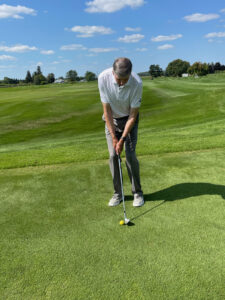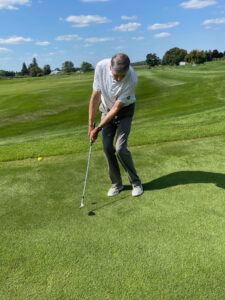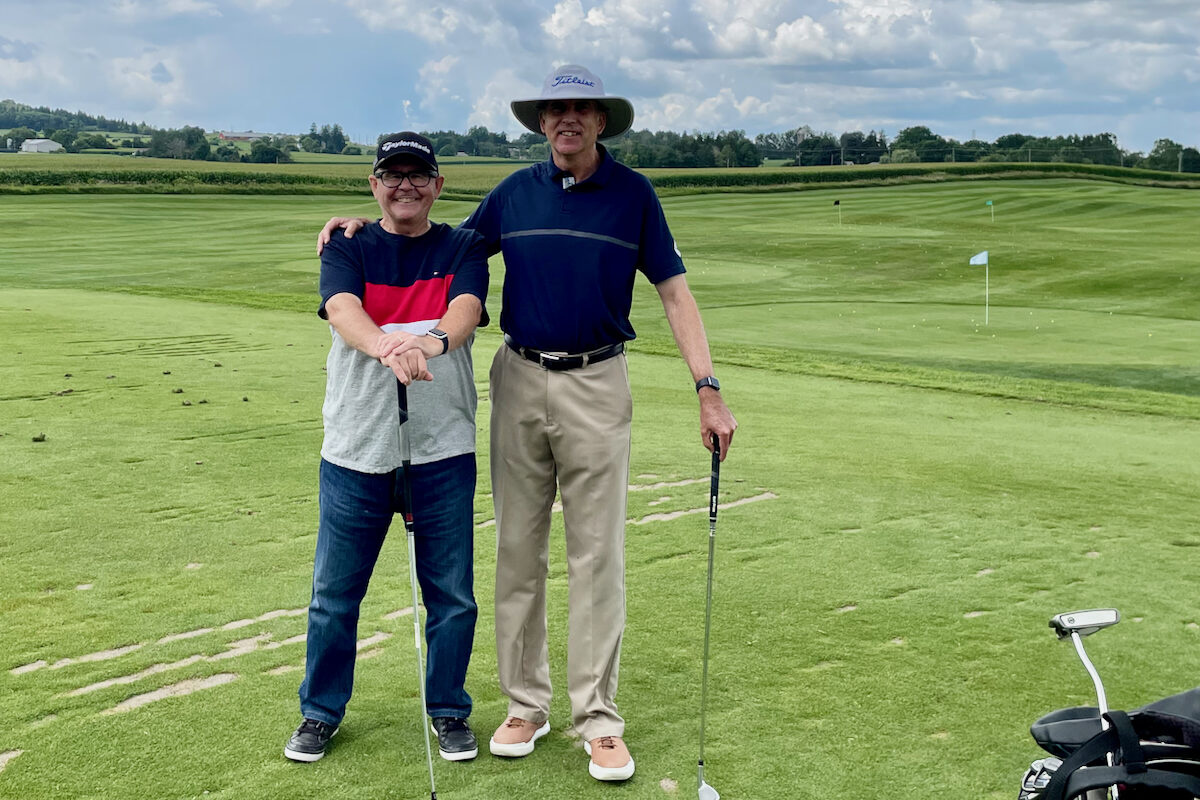Yes, I am one of those retired people who actually did ramp up his golfing game once I left the workplace behind. And yes, it’s also true that after having lost the fingertips on my eight fingers… thumbs are OK… and all my toes, I am currently playing the very best golf of my life. As you might expect, I have to play from the forward tees, but that really does not account for the turnaround.
If you are interested in reading about my long, harrowing and mostly interesting brush with death you can read all about it in a piece I posted shortly after I was discharged to participate in a supported recovery program at home. The post, linked here, is entitled, “I Almost Died … Seriously”, quasi compelling, quasi enjoyable reading.
So, what has led to this serious improvement in my golf game? I ascribe it all completely to the fact that I am working with a great golf instructor. He is Robert Hannah, Head Teaching Professional at the Golf North Academy at Rebel Creek Golf Club in Petersburg, Ontario. You can download his attached information and pricing document if you would like to read more about his services.
I have worked on and off with Robert over the last few years, but it is really since my physical condition changed so dramatically that I have really benefitted from his instruction. I would have to say this is very indicative of his approach as a golf teaching professional. He is one of those instructors who is committed to working with golfers of all abilities and has a very good sense of how to work with “what they’ve got”. And in my case, that is not too much. 🙂
I suppose by way of proof I would offer up the following scorecard from this summer when I had the lowest round of my golfing career, an 81. To low handicap golfers this probably doesn’t seem like such a terribly great score, but to a “mid handicapper” (18) like myself, it felt like I was shooting the lights out.
To put the 81 in context, over the years I would aspire each summer to have at least two or three rounds in the 80s. I have consistently scored in the low 90s prior to this year. As I write this in August, I have already had nine rounds in the 80s, and I figure to have a few more before the season ends.
Because of this I am completely convinced that working with a golf pro would be of great benefit to any golfer – especially we incredibly average ones. 🙂 I suppose the caveat to that would be that you need to find someone who you work with well. It should be someone who has the ability to look at what you have already and has an understanding of how they can help you improve your game.
Let’s begin this little undertaking by looking at what I consider it be the benefits of working with a professional golf instructor.
The Benefits of Working with a Golf Instructor
In no particular order, here are my thoughts:
1) Trained Observer – A good instructor has observed thousands of different golf shots and many different types of golf shots, has a very good sense of what it takes to make shots properly, and can see what you are doing incorrectly.
2) Instant Feedback – Given his or her understanding about how to make good golf shots, he or she can advise you in the moment about what you were doing wrong and make suggestions on how to change.
3) Pre-shot Routine – An instructor can help you understand, and help you develop what you need to think about and do leading up to a golf shot. Many of us simply step up to the ball and have a go at it. This is not a winning formula over the long-haul.
4) Tools – A good teaching professional has a variety of instructional tools that he or she can use to help you better understand and improve your skills. Typically, these are expensive items that you would never go out and purchase for yourself. These tools are used to provide observable feedback on your shot making. You get to see what you were doing right and what you were doing wrong. This is much more constructive then just being told about it.
5) Knowledge Base – I am always impressed with the amount of information that Robert has retained about my game even after I haven’t worked him in a long time. By way of example, I had not had a lesson between 2019 and 2022 during my illness and long recovery… a period of three years. When I saw him, he immediately rhymed off my strengths and weaknesses. My favourite being that he remembered how good I was at making flop shots… might be the only good shot in my bag.
6) Mental Game – I not sure that most golfers understand how much of golf takes place between the ears. And to paraphrase and switch the context from one of Yogi Berra’s many great baseball malapropisms, “90% of golf is half mental”. For me, that is thinking things through and reminding myself to make good choices like making the safe recovery shot and not the heroic one… amongst a myriad of other important decisions that have to be made during a round.
7) Sounding Board – It’s great as a student of the game to have someone right there to discuss your thoughts about your technique and overall approach to the game as you are practicing.
8) Demonstrates Proper Execution – the other thing I really appreciate about working with Robert is that he can demonstrate exactly how to do the shots that he is trying to teach me.


Professional Golf Teaching Tools
To further elaborate about how a good instructor will have helpful instructional tools to work with, I offer a list of the ones that Robert uses when working with his students. He was gracious enough to list them for me with a bit of an explanation on the purpose and benefits of each.
1) Pre-shot Preparation Handout – Robert provides students with a detailed handout with steps and suggestions on how to prepare yourself mentally and physically for every shot.
This includes points like:
“How is the lie going to influence my shot options?”
“Given the shot presented, what is my highest percentage option based on my skill set?”
“Feel the swing you need to make to produce the desired shot using a short backswing.”
2) Foresight GC2 Launch Monitor – A great tool for measuring ball flight results, such as spin rates,
launch angle, ball speed, and carry distance.
3) Onform Video Analysis and Coaching App – This app is a terrific communication tool, that can easily deliver a voiced-over video review of a student’s golf swing while also providing analysis and lesson summaries
4) Various left- and right-handed clubs – and a few other teaching aids collected over the years.
Onform Video Clip
Attributes of a Successful Student
I also asked Robert if he would share his thoughts about what attributes individuals should possess that will help them achieve positive results when taking lessons. I was interested in his thoughts on this because I have spoken to a few people over the years who didn’t find any real benefit in taking lessons… was that because of the instructor, or because of the golfer?
1) Open Mind – A student should come with an open mind and a desire to learn.
2) Be Receptive – Golfers should be receptive to clearing up misconceptions and targeting the most important topics to focus on for their improvement. Some golfers come with preconceived ideas of what they should be working on with their swing.
3) Patience – Having patience to focus on the most important swing keys is paramount
4) Practice – Practice of the concepts presented in lessons is very important… very important! (I stress this to remind myself because Robert and I joke about how unwilling I am to come to the range and practice. 🙂 … you on the other-hand, should practice)
.
Attributes of a Good Golf Instructor
And then I threw Robert a curveball… at least that’s what I thought it was :-). I asked him to identify what he felt are the attributes of a good golf instructor. This was what he came up with:
1) Has Spent Time Learning – about things like swing and short game techniques, how limitations with the body can influence swing motions, etc. (In over 20+ years of teaching Robert’s commitment to learning has craft has resulted in him becoming certified as a “Titleist Performance Institute Certified Golf Fitness Instructor”.)
This makes me think about Malcolm Gladwell’s reference to the “10,000-hour rule”, in his book Outliers: The Story of Success. He claims that the key to mastering any skill is a matter of practicing in the correct way, for at least 10,000 hours.
2) Should be Organized – Keeps files on student lessons, has equipment ready before the student arrives, has lesson plans set prior to lessons, etc.
3) Should be Experienced – Through working with many golfers, instructors learn common tendencies and the techniques that can help the majority of golfers
4) Should be a Good Communicator – Be able to explain the keys/techniques to improvement through speaking, demonstrating, or using video analysis
What Worked for Me
After providing all that background information it is time to discuss how all of that worked for me. Did the lessons lead to the turnaround or was it simply good luck and me improving slightly on how I was already playing? I think there’s a body of evidence to suggest that it was, in fact, the lessons. I will briefly look at them individually.
1) Driver Use – a few years prior to returning to work with Robert in 2022, I had given up on using the driver and was taking all of my tee shots with a four iron. That resulted in more drives in the fairway for sure, but they were much shorter than what could be achieved with a driver. Every par four hole instantly became a par five, because there was no way I was getting on the green in two strokes.
Robert broke down my driver approach and replaced it with one that involves a much shorter takeaway and a much shorter follow through… i.e. controlled. This resulted in drives of an appropriate length and solidly in the fairway most times. Longer drives means less distance to the green, which means fewer strokes taken in a round overall.
2) Quiet Body – Secondly, Robert has got me thinking about having a more solid set up in an attempt to eliminate the swaying that was taking place in my swing. This might be costing me some distance, but it is certainly allowing me to make better contact most of the time, thus eliminating botched shots.
3) Practice Swings – I probably should be talking about pre-shot routine in its totality here but I think the thing that really helps me the most before pulling the trigger on any shot is to take three practice swings; paying close attention to the execution and feel and in what direction the ball will probably head after I complete the swing.
4) Short Take-away – I mentioned this when talking about the driver, but I also do this with all of my shots. While I am pulling back it feels like I’m taking a very short backswing, but when I watch Robert’s videos, I can see that it is a reasonable one. He has eliminated the really long backswing in my game.
5) Weight on Left Foot – All golfers know that when they complete their swing most of their weight should be on their left foot with their right foot simply resting on the ground, toe down. This requires a very subtle shift in weight during every swing.
This has been something that I have not been able to master but Robert came up with a solution. For every shot… with the exception of a couple where my weight needs to be primarily on my back foot… I start each swing with most of my weight already resting on my front foot. If I start there, then I end up there. This really helps me to execute a proper shot.
6) Mental Approach – Robert has certainly also helped me improve my mental approach to the game. Long gone are the thoughts about making heroic recovery shots or even slightly risky ones. The net result is a very noticeable drop in “blow up” holes that always lead to high scores.
I suppose I could go on and identify a few more aspects of my game that Robert has tightened up, but I think you have probably gotten the point by now. Yes, there are lots of things that I still need to work on – like my short game and how much I rotate my body during the swing, but I am thrilled with the simple changes that Robert has brought to my game and the resulting lower scores.
Working with a golf professional has certainly helped my game and I would suggest that if you have never taken lessons before, that you try it next golf season. What have you got to lose? Oh right… several strokes off your game probably.
The Intangibles
It is my feeling that working on improving my golf game with Robert has had some other intangible benefits for me. I am still in an extended recovery mode physically. I need to improve my fitness; I need to improve my walking gait; and I need to work on shaking off the extra pounds I have packed on while living with the reality of reduced mobility. I remain a recovering work in progress.
That said, when my friends point out to me that I am playing the best golf of my life, that provides a very powerful incentive to keep working at all the other things I need to work on physically. It is all doable. If I can improve my golf game at this point, I can improve at just about everything else.
A Final Shout Out
And to wrap it all up a final shout out to Robert Hannah.
Robert primarily works with adult golfers, but occasionally he has been known to work with junior golfers as well. This summer he was recognized in an article about a junior golfer from the area who is now a member of UBC Okanagan golf team for working with him when he began to take the game seriously. The article can be found here.
Thank you, Robert. Working with you has had a very positive impact on my golf game, but perhaps more importantly it has also had a wonderful effect on my overall recovery. It is no wonder that you are held in such high regard by the golf community in Waterloo Region.




